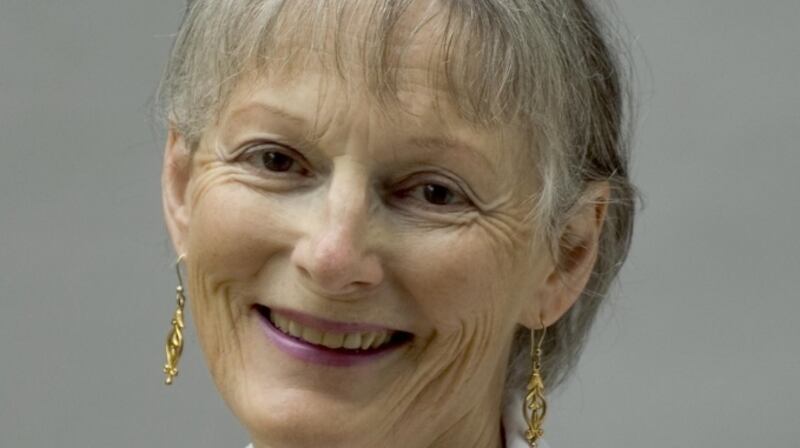Judith Kazantzis
Born: August 14th, 1940
Died: September 18th, 2018
Judith Kazantzis, who has died aged 78, produced tense, taut poems as delicate and strong as spiders’ webs. A scion of the Anglo-Irish Packenham family – her father was Lord Longford – she had a lifelong passion for weaving words together in playful and intriguing ways that mirrored her simultaneous commitment to making connections in life and politics, between love and activism, and, as an artist, between words and images.
She published 12 collections of poetry, as well as essays, and a novel, Of Love and Terror (2002). Part of an impressive generation of female poets including Fleur Adcock, Gillian Clarke, Alison Fell and Penelope Shuttle, she examined the traps and seductions of power relationships, domestic, sexual, social. She could be savagely witty; never didactic.

She employed a vernacular that could be tart, bawdy, lyrical, satirical by turns
New wine demanded new bottles: beginning with Minefield (1977), she composed spare, tightly controlled free verse unafraid of gaps and jumps. She employed a vernacular that could be tart, bawdy, lyrical, satirical by turns.
Some of these pioneering early poems explore the role of women in myths and fairytales, as powerful but vulnerable goddesses, as angry drudges, as ambivalent mothers, as contradictory daughters. Angela Carter and Sara Maitland, along with others, were doing this in prose; Kazantzis took on a western poetic tradition that named women more as muses and monsters than as makers. In the essay she contributed to Michelene Wandor's 1983 anthology On Gender and Writing, Kazantzis explained how she redrafted Clytemnestra, for example, "not as a crazy bitch, but as a human being with strong passions and good reasons".
Collections
In the 1980s Kazantzis broadened her definition of power and of politics and began to publish collections, such as A Poem for Guatemala (1986) and Flame Tree (1988), that made strong political statements and embodied a committed political stance. Her collection Just After Midnight (2004) reveals how, if she was writing tender elegies for the personally known dead, she was also creating memorials to witness those dying in Tiananmen Square, or in the Jenin camp on the West Bank.
In Sister Invention (2014), the poems sneak up on both the powerful and the weak, eavesdropping, spying, reporting back to the reader in intimate, deadpan tones, mixing slapstick and surrealism to convey the horrors of hi-tech warfare.
Yet, in this same volume, Kazantzis's imagination also encompasses journeys around North American landscapes, pilgrimages across the terrain of family and of love. A single poem, such as Who Loved Me, can combine a dreaming English child's love for ponies and for Jesus with an image of the sea as "a thick red tongue/ lapping from the arteries of Iraq".
Despite their subject matter appearing explicit, despite their forensic exactness, often her poems refuse easy readings, do not offer neatly tied-up endings. She could be a poet of what Keats termed “negative capability”, able to rest in not-knowing, relying on the reader to do the same.
Throughout her life Kazantzis developed her artist’s practice, working in watercolour, scraperboard and printmaking, learning from and collaborating with artists such as Carolyn Trant, showing her work in local exhibitions or at home. Despite chronic, debilitating back pain, she supported and befriended younger artists, and mentored younger poets, sharing her expertise.
Early life
Born in Oxford, she was the fourth child of Frank Pakenham, Lord Longford, the Labour politician and social reformer, and Elizabeth (nee Harman), Lady Longford, the historian. One of the last debutantes to be presented at court as part of the season, subsequently she refused to use her title. She attended convent school and took a history degree at Somerville College, Oxford, in 1961. Two years later she married Alec Kazantzis , and they had two children, Miranda and Arthur.
During the 70s she worked for the first Women's Liberation Workshop in London, became a member of the Women's Literature Collective, reviewed poetry for Spare Rib and other journals, and taught writing via the Inner London Education Authority.
Kazantzis campaigned against modern slavery, the arms trade, nuclear weapons, illegal occupations; against all abuses of power
Her marriage to Alec ended in divorce in 1982, and in 1998 she married the American writer Irving Weinman. They spent regular time in Key West, Florida, where Irving taught, then made their base in Lewes, East Sussex, where both of them became actively involved in politics. Kazantzis campaigned against modern slavery, the arms trade, nuclear weapons, illegal occupations; against all abuses of power.
Irving died in 2015. Kazantzis is survived by Miranda and Arthur, two stepchildren and her siblings Antonia, Thomas, Rachel, Michael and Kevin. – Guardian Service









